So you want to save the Cranker? Here’s how to have your say

Many readers were shocked to find out that Adelaide could lose one of its best live music venues, the Crown & Anchor hotel, to high-rise development. So, we talked to PlanSA to find out more about how you can voice your concerns.
Making a formal submission to comment on a proposed development can be a daunting task, so CityMag has compiled a step-by-step guide to help you with the process.
The Crown & Anchor – affectionately known as the Cranker – is under threat from redevelopment into a student housing block by a Singapore-based company, Wee Hur Holdings. If this development is approved, the student housing would be 19 storeys, and the Cranker would be no more.
The proposed development at the Crown & Anchor site, which also homes Midnight Spaghetti, Roxie’s and Chateau Apollo, is classified as a notified development and is currently on public notice – meaning anyone in South Australia can have a say on what they think of the plans.
PlanSA is an online planning portal, which is run by the state government’s planning department. Developments can be lodged and monitored, while members of the community can make submissions using the PlanSA website.
The ‘Save the Cranker’ campaign is encouraging community members to make submissions to the State Commission Assessment Panel (SCAP), who are the decision-makers on developments.
You can submit your view on the Cranker development no matter which position you take.
Before launching into our how-to guide, it should be stressed that in talking to CityMag, PlanSA is not taking a position for or against the development.
Step 1: Making a representation
You might like
To make a formal submission, you will need to make what is called a “representation”.
Making a representation can either be done via the PlanSA website or you can complete the form and send it by email.
You’ll need to know the application ID for the Cranker development: 24003065 or click on this link.
Your representation will be considered by the SCAP when they assess the application.
Representations can be made either in support of or opposed to a proposed development.
You will find all the relevant documents about the proposed development to help you with your submission on the PlanSA website, including architectural plans, the heritage impact statement, and various other reports.
According to PlanSA, a valid representation must:
- “be in writing and submitted within the prescribed timeframe (15 business days);
- outline the reasons for the representation;
- include your name and address;
- [and be] limited to matters to which the relevant authority will undertake an assessment of the application”.
For example, your submission may address issues such as land use, design and appearance, heritage impact, traffic and noise impacts, and impacts on local amenities – meaning the pleasantness or attractiveness of a place.
PlanSA says a representation not addressing these points will be considered invalid and won’t be considered by SCAP when assessing the development application.
Subscribe for updates
A copy of your representation will also be given to the applicant (Wee Hur Holdings), who will have a right to respond to any particular points you have made.
Step 2: Do you want to deliver your submission in person?
After you have filled in your details, you will need to choose whether you want to be heard in support of your representation.
If you say you wish to be heard, you will be invited to the hearing where the outcome of the proposed development is decided.
In the next step of your representation, you will have 4000 characters to make your case either for or against the development.
If that’s not enough words for you and you have more to say, you can submit a PDF as well as attach any additional supporting documents.
Step 3: The public hearing
At this stage, we don’t know when the hearing will be. PlanSA says the timeframe for the public hearing can vary after the consultation period closes, but that anyone is welcome to attend.
“Only applicants and valid representors who have indicated prior to the meeting a wish to be heard on an application will be able to speak to the panel members at this time,” they said.
At this meeting, you have five minutes to make your case, although you can also choose someone else to speak on your behalf.
“Verbal submissions of representors must be limited to no more than five minutes and will be managed in accordance with SCAP Practice and Operating Directions,” says PlanSA.
“It is recommended that representors highlight those issues of greatest concern and are encouraged to elaborate on issues or raise new issues, rather than reproduce their written submissions.”
Step 4: The outcome
Following this hearing, everyone who made a representation will receive an email informing them of the outcome.
If you or someone who has submitted a representation to PlanSA are unhappy with the outcome, you can appeal to the Environment, Resources and Development Court.
The developer (in this case, Wee Hur Holdings) may also challenge the outcome.





